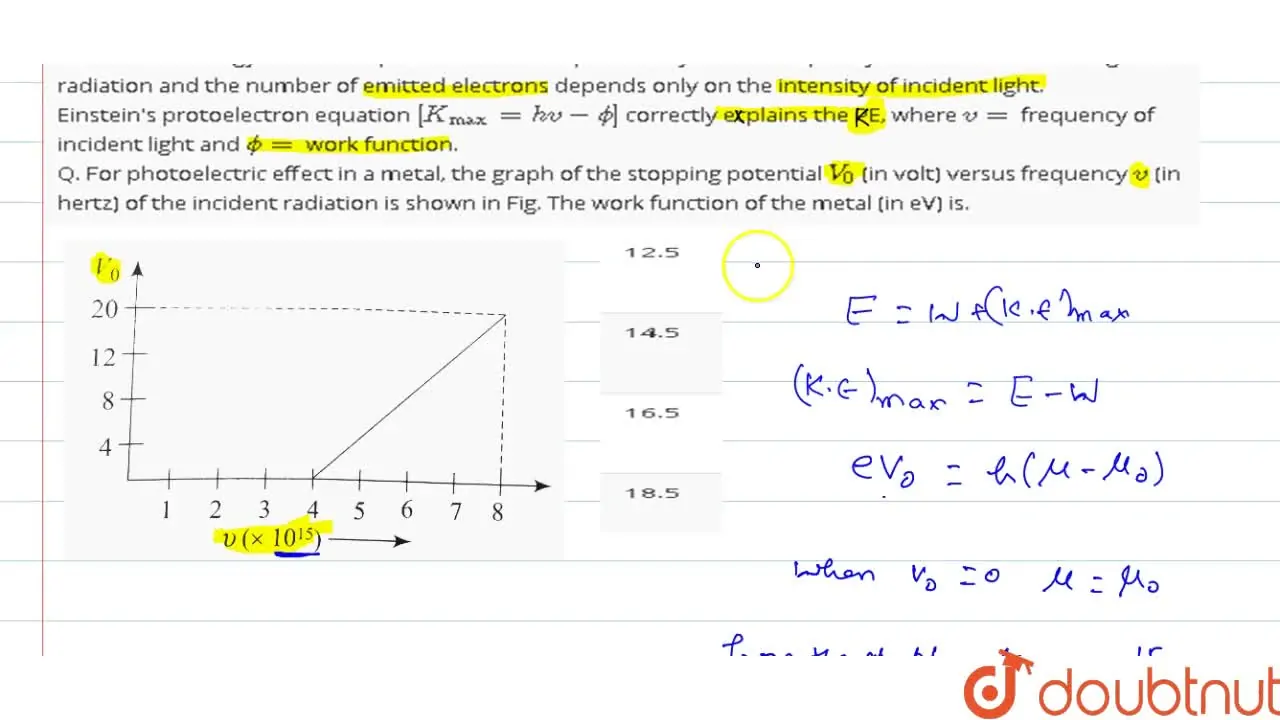![When a high frequency electromagnetic radiation is incident on a metallic surface, electrons are emitted from the surface. Energy of emitted photoelectrons depends only on the frequency of incident electromagnetic radiation and the number of emitted electrons depends only on the intensity of incident light. Einstein's protoelectron equation [K(max)=hv-phi] correctly ecplains the PE, where upsilon= frequency of incident light and phi= work function. Q. For photoelectric effect in a metal, the graph of the stopping potential V0 (in volt) versus frequency upsilon (in hertz) of the incident radiation is shown in Fig. The work function of the metal (in eV) is.](https://d10lpgp6xz60nq.cloudfront.net/physics_images/BMS_V04_C03_E01_213_Q01.png)
When a high frequency electromagnetic radiation is incident on a metallic surface, electrons are emitted from the surface. Energy of emitted photoelectrons depends only on the frequency of incident electromagnetic radiation and the number of emitted electrons depends only on the intensity of incident light.
Einstein's protoelectron equation [Kmax=hv−ϕ] correctly ecplains the PE, where υ= frequency of incident light and ϕ= work function.
Q. For photoelectric effect in a metal, the graph of the stopping potential V0 (in volt) versus frequency υ (in hertz) of the incident radiation is shown in Fig. The work function of the metal (in eV) is.
12.5
14.5
16.5
18.5
The correct Answer is:C
eV0=h(v−v0)
When V0=0,v=v0, the threshold frequency.
From the graph it follows that
v0=4×1015Hz
Therefore, work function is
ϕ=hv0=6.6×10−34×3×1015
=16.5eV
Related Playlists
- BOOK - CENGAGE PHYSICSCHAPTER - PHOTOELECTRIC EFFECTEXERCISE - Integer9videos
PHOTOELECTRIC EFFECT
- BOOK - CENGAGE PHYSICSCHAPTER - PHOTOELECTRIC EFFECTEXERCISE - Single Correct Answer Type7videos
PHOTOELECTRIC EFFECT
- BOOK - CENGAGE PHYSICSCHAPTER - PHOTOELECTRIC EFFECTEXERCISE - Multiple Correct10videos
PHOTOELECTRIC EFFECT
- BOOK - CENGAGE PHYSICSCHAPTER - NUCLEIEXERCISE - QUESTION BANK59videos
NUCLEI
- BOOK - CENGAGE PHYSICSCHAPTER - RAY OPTICSEXERCISE - DPP 1.612videos
RAY OPTICS
Similar Questions
When a high frequency electromagnetic radiation is incident on a metallic surface, electrons are emitted from the surface. Energy of emitted photoelectrons depends only on the frequency of incident electromagnetic radiation and the number of emitted electrons depends only on the intensity of incident light.
Einstein's protoelectron equation [Kmax=hv−ϕ} correctly ecplains the PE, where υ= frequency of incident light and ϕ= work function.
Q. Light of wavlength 3300 is incident on two metals A and B, whose work function are 4 eV and 2 eV, respectively. ThenView SolutionWhen a high frequency electromagnetic radiation is incident on a metallic surface, electrons are emitted from the surface. Energy of emitted photoelectrons depends only on the frequency of incident electromagnetic radiation and the number of emitted electrons depends only on the intensity of incident light.
Einstein's protoelectron equation [Kmax=hv−ϕ} correctly ecplains the PE, where υ= frequency of incident light and ϕ= work function.
Q. The slope of the graph shown if Fig. [here h is the Planck's constant and e is the charge of an electron] isView SolutionWhen light is incident on a surface, photoelectrons are emitted. For photoelectrons,
View SolutionIn photoelectric effect, the number of emitted photoelectrons is proportional to _____ of incident light.
View SolutionIf frequency of radiation incident on a photosensitive surface is doubled, the maximum kinetic energy of emitted photoelectrons also gets doubled.
View SolutionStatement-1: Kinetic energy of photoelectrons increases with increases in the frequency of incident radiation
Statement-2: The number of photoelectrons ejected increases with increases in intensity of incident radiation.View SolutionWhen yellow light is incident over a metal surface no electrons are emitted while green light can emit electrons if red light is incident over the surface then
View SolutionIn photoelectric effect on metals, an increase in the frequency of incident radiation increases:
View SolutionAssertion: Kinetic energy of photoelectrons emitted by a photosensitive surface depends upon the frequency of incident photons, provided that it is greater than the threshold frequency.
Reason: Number of photoelectrons depends on the intensity of incident radiation.View SolutionAssertion : Photoelectric current depends on the intensity of incident light.
Reason : Number of photoelectrons emitted per second is directly proportional to intensity of incident radiation.View Solution


